Traditional wrestling in Senegal – much more than a sport, it keeps culture alive

Traditional wrestling plays an important role in much of Senegalese society and is one of the national sports of the country.
Traditional wrestling is mainly practiced in rural areas where it is not just a sport but has a profound social and cultural role. It is overshadowed by a very popular modern day professional wrestling. A synthesis of boxing and traditional wrestling, these matches are a huge social event.
It is particularly important in the Joola community of southern Senegal and the Serer community of central Senegal. Together, these communities account for about 18% of the country’s population.
The practice is traditionally taught to young men in special schools during their initiation into adulthood.
All information on how to wrestle was handed down orally by griots – traditional West African troubadour historians – and by the elders.
The young men learn about society, hierarchy and the fundamental differences between the traditional roles of men and women. The training schools also bring together people from different communities. In this way, rings enable friendly encounters between neighboring villages, especially in rural areas.
Wrestling is not just a sport, it is a valuable social legacy that must be carried on. It’s in decline because young wrestlers are drawn to the professional, modern forms.
Importance of oral tradition
Because wrestling was handed down through oral history, there are almost no written documents about it. As a wrestling specialist who I have researched extensively, I would like to point out that everything we know about the history of traditional wrestling was told to us by the elders and griots.
According to the Elders and Griots, wrestling was a means of settling conflicts between kings through wrestlers. Apart from that, it was practiced as a recreational sport.
Wrestling in the Serer community has some additional cultural dimensions—it’s also a literature, a ritual, and a celebration. The wrestling is accompanied by different rhythms that change depending on the wrestler himself and the participating group. It can be slow, silent, fast, jerky, fiery. It creates a story, encouragement, speaks directly to the wrestler but also to all participants.
Chants like “The chests scream when a big wrestler goes down, let’s go, it’s dark already” or “I’m a regular in the arena, but I won’t run around looking for talismans, my strength is enough”. often sung by her followers.
Wrestling is not just a sport, it has a significant socio-pedagogical aspect.
There are wrestling training schools for all boys, and through them adults gauged the boys’ courage, will to win, and spirit of self-sacrifice. For this reason it brings honor to a person’s village or region and is an important form of social capital to be preserved.
Socially anchored
Traditional wrestling is more than just the individual wrestling. There are five major social dynamics surrounding wrestlers: the relationship between the wrestler and his entourage; the relationship between wrestling and family relationships; the relationship between wrestling and friendship; between the elders and wrestling; and finally the contribution of the struggle to bringing people together.
Traditional wrestling is also important to the community – it’s an expression of ethnicity, tribe or class. Wrestling in traditional society was a sign of the vitality of a particular community. This community gathers all its forces around a single character – the wrestlers – as its representative.
The relationship between the wrestler and their community is therefore crucial. Three relationships in particular stand out:
-
The wrestler’s champion and his group or community: The wrestler draws his strength from this group, which supports and encourages him in his preparation and during the match. It is believed that a champion who cuts himself off from his group loses some of his power.
-
The age group: This represents young people of the same age. Within this age group, the wrestler can measure their strength against others.
-
The role of the mother, the sister and the “scholars” (the wise men of the community), who felt particularly mobilized to protect their “son” and ensure his victory. Wrestlers often wear their symbols, for example wearing a sister’s loincloth means the wrestler is fighting for the honor of the family.
Switch to professional wrestling
Traditional wrestling is part of Senegal’s cultural heritage, which includes social integration and education, but its true form is dying out. Nowadays, most people tend to focus more on professional wrestling.
Aside from the Flag of the Head of State – a national wrestling tournament dedicated to the head of state that brings together wrestlers from every region of the country – organized by the National Management Committee (the body responsible for managing wrestling), traditional wrestling is absent in the country’s cultural-political projects and programmes.
The Ministries of Sport and Culture must invest in preserving and enhancing Senegalese traditional society, including traditional wrestling.
A version of this article was originally published in French. You can read it here
This article is republished by The Conversation, a nonprofit news site dedicated to exchanging ideas from academic experts. The Conversation has a variety of fascinating free newsletters.
It was written by: Ousmane Ba, University Cheikh Anta Diop de Dakar.
Continue reading:
Ousmane Ba does not work for, consult with, own an interest in, or receive funding from any company or organization that would benefit from this article, and has disclosed no relevant affiliations other than her academic appointment.